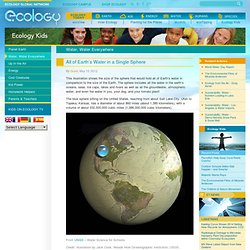

All of Earth's Water in a Single Sphere. This illustration shows the size of the sphere that would hold all of Earth’s water in comparison to the size of the Earth.

The sphere includes all the water in the earth’s oceans, seas, ice caps, lakes and rivers as well as all the groundwater, atmospheric water, and even the water in you, your dog, and your tomato plant! The blue sphere sitting on the United States, reaching from about Salt Lake City, Utah to Topeka, Kansas, has a diameter of about 860 miles (about 1,385 kilometers), with a volume of about 332,500,000 cubic miles (1,386,000,000 cubic kilometers). From USGS – Water Science for Schools Credit: Illustration by Jack Cook, Woods Hole Oceanographic Institution; USGS.. Data source: Igor Shiklomanov’s chapter “World fresh water resources” in Peter H. You might also like:
Salmon flood hatcheries, great 2012 predicted. Photo Coleman National Fish Hatchery jumping-salmon Salmon jumps over white water and steps in fish ladders to reach hatcheries Salmon have flooded into state and federal fish hatcheries in the past month.

The key indicator, the arrival of two-year-old salmon, also predicts the ocean off the Bay Area coast will be full of fish next summer. Trips to Nimbus Hatchery last week on the American River near Sacramento and to the Coleman National Fish Hatchery on Battle Creek near the Sacramento River unveiled great news for salmon, the people who fish for them, and those who love to eat them. At Nimbus, adults and youngsters alike watched the salmon swim up the American River, jump up the fish ladders to the hatchery, and occasionally make spectacular jumps in the river. All the news is good. At Coleman, 55,000 spawn-ready salmon returned to Battle Creek this fall, 42,000 to the hatchery, up from lows of 14,000 and 10,000, respectively in 2008, reported Brett Galyean at the hatchery.
Eco-friendly disposal of dog waste: bag or flush? Dilemma: Short of training my dog to hold it, is there a eco-friendly way to get rid of dog waste that's still sanitary? Of course I'll: Bag it and throw it in the garbage. Trade-off: I'm not sure the bag breaks down if it goes to the landfill. Then I'll: Flush it. Trade-off: Can the sewer system handle it? Experts say: Proper disposal of dog waste isn't just about keeping streets and parks clean; it's a minimum requirement for ensuring public health. Biodegradable and bio-based bags, such as those made of corn, are a good choice if you're trying to stay away from petroleum-based products. Darby Hoover, senior resource specialist for the Natural Resources Defense Council, says: "Most landfills operating today are designed with the idea that they should protect the environment as much as possible - they are built with numerous layers of liners and cover systems in place to help reduce leakage and so forth.
We'll cover eco-friendly options for cat waste disposal next time. Are Americans Ready to Start Drinking Their (Treated) Toilet Water? As the American Southwest reels from one of the worst droughts on record, some parched communities are opting for a once-unthinkable conservation measure: extracting drinking water from urine and other liquid waste.

The small Texas city of Big Spring is the latest to take the plunge, announcing that late next year it will begin adding 2 million gallons of recycled water daily to the drinking supply. San Diego recently began a pilot project of its own, hoping to make believers of the one-third of its population who oppose or are unsure about the technique. While so-called toilet-to-tap ventures certainly sound unpleasant, skeptical citizens should take heed of the rigorous filtration process that makes recycled wastewater as safe to drink as conventional tap water.
Sewer water undergoes initial cleansing at a sanitation plant to remove solid waste and add beneficial bacteria that break down sludge. A recycling facility then forces the water through holes in tiny, strawlike fibers.